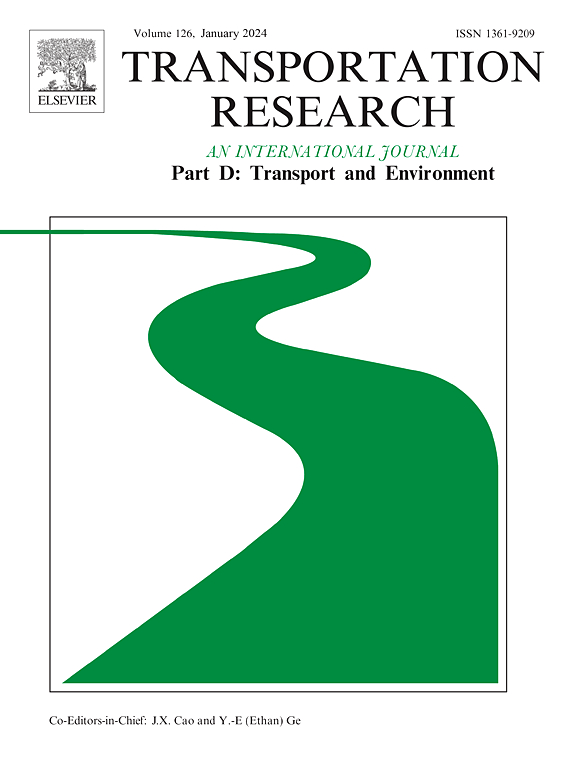改进氢动力飞机的经济和环境评估的综合框架
IF 7.7
1区 工程技术
Q1 ENVIRONMENTAL STUDIES
Transportation Research Part D-transport and Environment
Pub Date : 2025-08-06
DOI:10.1016/j.trd.2025.104947
引用次数: 0
摘要
到2050年实现航空业净零碳排放需要转向替代能源。虽然氢正在成为过渡的潜在选择,但有必要开发一个综合平台来评估改造现有飞机以使用氢的环境和经济(2E)影响。本研究介绍了氢动力飞机评估工具(HyAET),这是一个旨在评估改装氢动力飞机2E性能的框架。HyAET包括6条制氢途径、9个代表性飞机类别和7个全球地区,为航空业的战略决策提供了坚实的基础。结果表明,使用绿色氢(例如,使用可再生能源ere的电解)可以减少小型支线喷气机高达45%的二氧化碳当量排放量,同时也增加了约65%的直接运营成本。中型飞机,特别是窄体飞机,表现出最平衡的性能,当采用低碳氢(例如,ERE或可再生热分解)作为动力时,可以实现接近或低于1的经济环境指数(EEI)值。相比之下,无论飞行区域或燃料来源如何,非常大或非常小的飞机往往面临经济或环境处罚。敏感性分析显示,减少氮氧化物排放——尤其是大型飞机的氮氧化物排放——对于实现与煤油的环境平衡至关重要,需要减少30%才能实现收支平衡。最后,将坦克的重量效率从0.2提高到0.8,减少了所有级别的排放和DOC,加强了轻量化坦克技术的重要性。本文章由计算机程序翻译,如有差异,请以英文原文为准。
An integrated framework for the economic and environmental assessment of retrofitted hydrogen-powered aircraft
Achieving net-zero carbon emissions in aviation by 2050 requires a shift toward alternative energy sources. While hydrogen is emerging as a potential option for the transition, it is necessary to develop a comprehensive platform to evaluate the environmental and economic (2E) impacts of retrofitting existing aircraft for hydrogen use. This study introduces the Hydrogen-powered Aircraft Evaluation Tool (HyAET), a framework designed to assesses the 2E performance of retrofitted hydrogen-powered aircraft. HyAET incorporates six hydrogen production pathways, nine representative aircraft classes, and seven global regions, offering a robust foundation for strategic decision-making in the aviation sector. Results show that the use of green hydrogen (e.g., from electrolysis using renewable energy—ERE) can reduce CO2-equivalent emissions by up to 45% in small regional jets, it also increases direct operating costs by around 65%. Medium-sized aircraft, particularly narrow-body types, demonstrate the most balanced performance and can achieve economic-environmental index (EEI) values near or below 1 when powered by low-carbon hydrogen (e.g., ERE or renewable thermal splitting). In contrast, very large or very small aircraft often face economic or environmental penalties regardless of flight region or fuel source. Sensitivity analyses reveal that reductions in NOx emissions—especially for large aircraft—are essential to achieving environmental parity with kerosene, with a 30% cut required to break even. Finally, improving tank gravimetric efficiency from 0.2 to 0.8 reduces both emissions and DOC across all classes, reinforcing the importance of lightweight tank technologies.
求助全文
通过发布文献求助,成功后即可免费获取论文全文。
去求助
来源期刊
CiteScore
14.40
自引率
9.20%
发文量
314
审稿时长
39 days
期刊介绍:
Transportation Research Part D: Transport and Environment focuses on original research exploring the environmental impacts of transportation, policy responses to these impacts, and their implications for transportation system design, planning, and management. The journal comprehensively covers the interaction between transportation and the environment, ranging from local effects on specific geographical areas to global implications such as natural resource depletion and atmospheric pollution.
We welcome research papers across all transportation modes, including maritime, air, and land transportation, assessing their environmental impacts broadly. Papers addressing both mobile aspects and transportation infrastructure are considered. The journal prioritizes empirical findings and policy responses of regulatory, planning, technical, or fiscal nature. Articles are policy-driven, accessible, and applicable to readers from diverse disciplines, emphasizing relevance and practicality. We encourage interdisciplinary submissions and welcome contributions from economically developing and advanced countries alike, reflecting our international orientation.

 求助内容:
求助内容: 应助结果提醒方式:
应助结果提醒方式:


